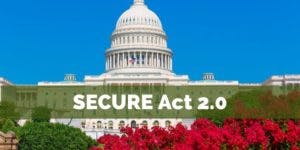Retirement Insights: New Legislation Could Change How You & Your Employees Save for Retirement
April 8, 2022
For once, Washington D.C. agrees on something – retirement savings. On March 29, 2022 the House passed a package of retirement reforms called SECURE 2.0 (Securing a Strong Retirement Act) by a vote of 414 to 5. If approved by the Senate, this legislation could have sweeping impact on retirement and retirement savings. Here are some of the highlights.
WORTH THE WAIT? The original SECURE Act raised the age at which you must start taking required minimum distributions (RMDs) from traditional IRAs and 401(k)s from age 70 ½ to 72. SECURE 2.0 would again raise the age to begin taking RMDS, this time to age 75 (phased in over time). That means you could have more time for your money to grow tax free, but if you delay RMDs your withdrawals may need to be larger.
AUTO EVERYTHING & EVERYONE! SECURE 2.0 would require employers to automatically enroll eligible workers in the firm’s 401(k) or 403(b) plans at a savings rate of 3% of salary. Enrolled workers’ contribution rates would automatically increase each year by 1% until their contribution reaches 10%. There are a few proposed exclusions (business with fewer than 10 employees, businesses that opened fewer than three years ago, to name a few).
CATCH ME IF YOU CAN. Currently workers who are at least 50 years old can make catch-up contributions to their 401(k) retirement accounts above the normal limits. For 2022, workers can contribute an extra $6,500 to their 401(k) after hitting the limits ($20,500 or $27,000 for those 50 or older). Under SECURE 2.0, workers who are age 62, 63, or 64 would be able to contribute even more – up to $10,000 in catch-up contributions.
LOST & FOUND. It can be challenging for employers to locate former workers, who have changed their name or address, to pay out benefits from a retirement plan. To make this easier, SECURE 2.0 would require the Department of Labor create a national online lost-and-found database for retirement plans.
MORE ROTH. Currently, SIMPLE and SEP IRAs are not allowed to accept Roth contributions from employees. SECURE 2.0 would change that. The proposed legislation would also require that catch-up contributions to 401(k)s and other qualified workplace retirement plans be subject to Roth treatment. This means that the extra $6,500 contributed by workers age 50 or older would automatically go into a Roth 401(k).
STUDENT DEBT. Traditionally, employers match participants’ contributions to their retirement accounts. However, some workers may be unable to fund their retirement account as they prioritize paying down student loans. The proposed legislation would allow employers to make matching contributions to a worker’s retirement account based on the worker’s own student loan payments. This would apply to 401(k), 403(b) plans, SIMPLE IRAs and 457(b) plans.
Follow along with future Allied communications as SECURE 2.0 moves through the Senate. Speaking of future communications, save the date for an upcoming web-based learning session we are hosting.
ADMINISTRATIVE BLUNDERS AND HOW TO AVOID THEM. Allied Investment Advisors, along with Montana-based Third Party Administrator Big Sky Retirement, will host a webinar on Thursday, May 5th from 10:00-10:45 AM. This practical and relevant session will highlight common administrative oversights made with 401(k) and other retirement plans. We’ll share best practices on how to avoid them and what to do if you encounter them. Watch for an upcoming invitation to register for the event.
